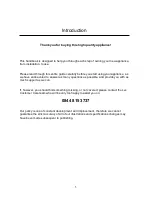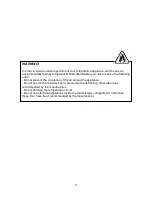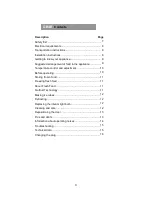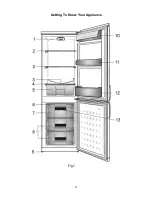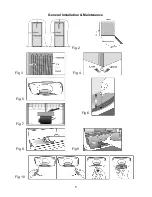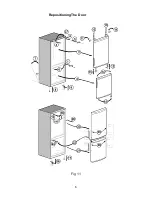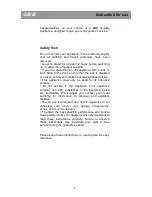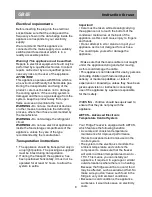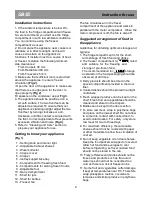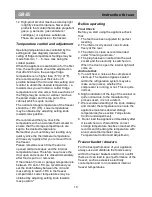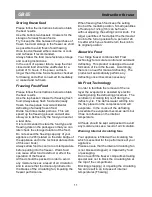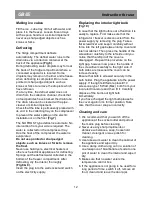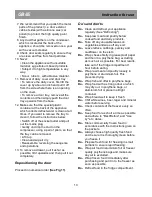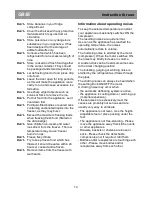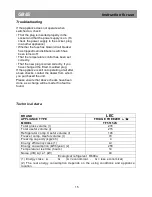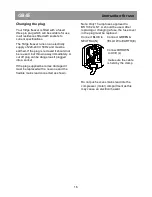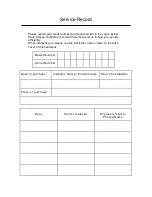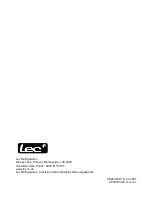
GB/IE
Instruction for use
Making ice cubes
Fill the ice - cube tray 3/4 full with water and
place it in the freezer. Loosen frozen trays
with a spoon handle or a similar implement;
never use sharp-edged objects such as
knives or forks.
Defrosting
The fridge compartment defrosts
automatically. The defrost water runs to the
drain tube via a collection container at the
back of the appliance (Fig 6).
During defrosting, water droplets may form at
the back of the fridge compartment where a
concealed evaporator is located. Some
droplets may remain on the liner and refreeze
when defrosting is completed. Do not use
pointed or sharp-edged objects such as
knives or forks to remove the droplets which
have refrozen.
If, at any time, the defrost water does not
drain from the collection channel, check that
no food particles have blocked the drain tube.
The drain tube can be cleared with a pipe-
cleaner or similar implement.
Check that the tube is permanently placed with
its end in the collecting tray on the compressor
to prevent the water spilling on the electric
installation or on the floor (Fig 7).
B) Freezer compartment
The NO FROST type defrost is compleetly
automatic. No intervention from your side is
required. The water is colected on the
compressor tray. Due the heat of the
compressor the water is evaporated
Do not use pointed or sharp-edged
objects, such as knives or forks to remove
the frost.
Never use hairdryers, electrical heaters or
other such electrical appliances for defrosting.
Sponge out the defrost water collected in the
bottom of the freezer compartment. After
defrosting, dry the interior thoroughly (Fig 8 &
9). Insert the plug into the wall socket and
switch on the electricity supply.
Storing frozen food
Please follow the instructions below to obtain
the best results.
Use the bottom two baskets / drawers for the
storage of already frozen foods.
Try to keep the time between the purchase of
frozen food and storage in the freezer as short
as possible to avoid frozen food thawing.
Once food is thawed either consume or cook
and re-freeze if recommended.
Always follow the food manufacturers storage
and cooking instructions.
In the event of a power failure, keep the door
closed and food should be unaffected for a
period of 14 hours, if the power cut lasts
longer than this time, food should be checked
for thawing and either consumed immediately
or cooked and re-frozen.
Freezing Fresh Food
Please follow the instructions below to obtain
the best results.
Use the top basket / drawer for freezing fresh
food: Always keep fresh food and already
frozen food separate to avoid accidental
defrosting of already frozen food.
Divide food into smaller portions. This will
speed up the freezing process and will also
allow you to defrost only the food you need at
a later date.
It is recommended to state the food type and
freezing date on the package so that you can
later check the storage duration of the food.
Do not exceed the freezing capacity of your
appliance in 24hr (stated on the data badge of
the appliance and in the technical data section
of this user book).
Always allow food to cool to room temperature
before putting into the freezer. Warm food
can cause other food to defrost or affect the
operation of the freezer.
All food should be packed in order to avoid
any moisture loss as a result of air circulation
and to ensure that food cannot protrude into
the blades of the circulating fan, impairing the
freezer performance.
GB/IE
Instruction for use
11
When freezing fresh food keep the setting
knob at the medium position. Small quantities
of food up to 1/2 kg (1lb) can be frozen
without adjusting the setting control knob. For
larger quantities of food adjust the thermostat
knob to the full on position for a period of 24
hrs after which you should return the knob to
its original position.
About No Frost
Your fridge freezer combines NO Frost
technology for accurate control and automatic
defrosting. This product is designed to avoid
formation of ice in the freezer. Accordingly,
there is no need for manual defrosting. The
product will automatically perform any
defrosting once it becomes necessary.
No Frost Technology
In order to facilitate the removal of the ice
layer the evaporator is assisted by electric
heating during the defrosting procedure. The
ventilator (circulating fan) is off during the
defrost cycle. The defrost water will drip into
the tray placed on the compressor and will
evaporate. In the course of the defrosting
procedure the evaporator becomes warm but
it has no influence on the internal
temperature.
All foods should be kept well packed to avoid
any moisture loss as a result of air circulation.
Warning: Internal circulating fans
Your appliance is fitted with a circulating fan
which is essential for the performance of your
appliance.
Please ensure that the internal circulating fan
is not blocked (stopped) or impaired by food
or packaging.
Do not overfill the freezer compartment taking
special care not to block the circulating fan at
the top of the compartment.
Blocking (stopping) or impairing the circulating
fan can result in an increase of internal
temperatures (Thawing).


